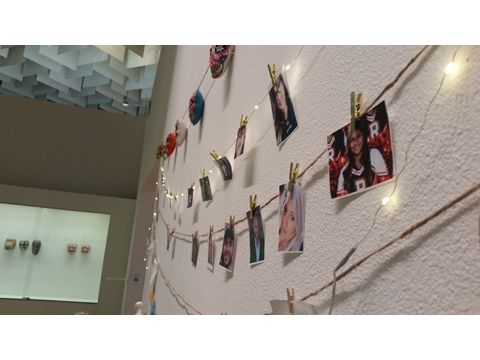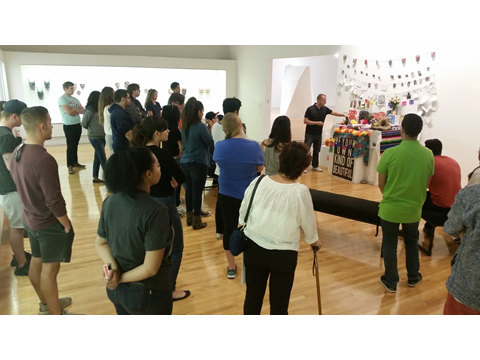Pop-up Ofrenda: Interactive Remembrance and Healing
18 April 2018 – Miriam Melton-Vilanueva.
public engagement, memory, museums, conference, material culture, 2018 annual meeting, Las Vegas Series 2018
Editor’s note: This is the fifth in a series of pieces focused on Las Vegas and its regional identity which will be posted before and during the NCPH annual meeting in Las Vegas in April.

UNLV Ofrenda in the Marjory Barrick Museum. Photo credit: Miriam Melton-Villanueva
As discussed in yesterday’s post, the Las Vegas shooting happened a month before Day of the Dead. This gave UNLV students an opportunity to grieve by building a Mexican ofrenda in the Marjory Barrick Museum. Community members, faculty, and students decorated a student-assembled platform with hand-made objects, stones, and words spontaneously written on scraps of paper. Someone brought the boots of a friend who died in the massacre; another added a picture of their grandfather. A student chef made a special artisanal bread that smelled of azahar (orange blossom); another student cut brightly colored tissue paper into geometric patterns. Flowers, candles, and sentimental objects were placed on the museum’s modular platforms, creating an expression of community strength.
For three hours at the 2018 NCPH annual meeting in Las Vegas, we reimagine this same intersection of art, memory and healing with a pop-up interactive table on April 19th (tomorrow), in Renaissance Ballroom I, in the conference hotel. As you stop by to see the images, we invite you to write notes and add them to the bits of poetry that continue to be written about life, brushes with death, and what it means to survive. You will be able to hold objects and textiles, and speak to students that wrote lines of poetry complex enough to hold humor alongside anguish.

Visitors to the UNLV Ofrenda commemorating the victims of the 2017 Las Vegas shooting. Photo credit: Miriam Melton-Villanueva
We all hold stories. Add your own voice to the chorus of hanging paper torn into strips. Help us build community around tragedy. Love notes, wishes, names of ancestors, dates, and lyrics will coexist for a moment, created with love. This profound cultural strategy we learn from Mexicans—how to cooperate despite our differences, how to celebrate death with wonder in order to heal the living. Be sure to join us.
Historical Context
Mexican plazas, schools, homes, and churches might participate in Día de los Muertos festivities today. During the colonial period, ofrendas appeared in association with the Christian calendar on All Saints’ Day. But in Mexico, the tradition can be traced back to the indigenous Aztec/ Mexica/ Nahua celebration called miccailhuitl in the Nahuatl language, which translates to “Day of the Dead.” These celebrations were planned for far in advance and sponsored by harvests from parcels of land inherited expressly for this purpose. By means of seasonal planting, weeding, watering, and harvesting these specific properties, one remembered loved ones and grandparents in the yearly celebrations with costly flowers, incense, and candles. Editor’s note: This tradition was also celebrated in popular culture with the recent 2017 Disney Pixar film, Coco.
~ Miriam Melton-Villanueva is an assistant professor in the history department at UNLV. Her recent book is The Aztecs at Independence: Nahua Culture Makers in Central Mexico, 1799-1832 is based on Nahuatl-language (“Aztec”/ Mexica) documents women and men produced during the colonial period.




It was so moving to see this in Las Vegas, especially right before the panel on exhibiting tragedy. It raised a lot of very important questions for me especially RE what may be lost when an exhibit moves from “temporary” to “permanent,” and what role ritual (for example annual observances) play in the rhythm of remembrance. Also, what does it mean to have a “civic culture of grief and remembrance?”